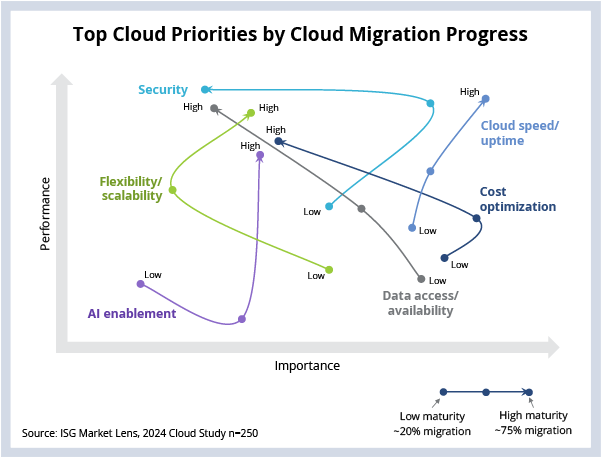Hello. This is Alex Bakker and Michael Dornan with what’s important in the IT and business services industry this week.
If someone forwarded you this briefing, consider subscribing here.
The Cloud
ISG Market Lens recently completed a study of 250 large enterprises on their adoption of cloud – including enterprise challenges, objectives, maturity and plans for the future. One finding that stands out in the IT services market data is that, as enterprises migrate more of their environment to the cloud, their performance increases across categories. This dynamic has implications for how service providers can work with companies across the cloud-migration spectrum to achieve their outcomes.
Data Watch

What You Need to Know
We examined how organizations rate the importance of various reasons for cloud adoption and their performance in those areas. In the Data Watch above, dots in the lower right indicate priorities where enterprises need the most help; dots in the upper left show priorities where enterprise performance exceeds importance. These are areas where a provider will not be able to help differentiate. The lower left and upper right quadrants are areas where performance and importance are relatively aligned, so capabilities are best seen as table stakes.
When we segment the data by the degree to which an enterprise has already completed cloud migration, a strong trend emerges: organizations with relatively low cloud migration maturity have a concentration of challenges where they experience an intersection of high importance and low performance. This intersection exists for them in cost optimization, data access, cloud speed and uptime, security and flexibility.
On the other end of the spectrum, enterprises with greater cloud migration maturity experience the intersection of significantly less importance and more highly performing in all areas except speed/uptime. As organizations mature their capabilities in these areas, the degree to which they prioritize them lessens.
There are two major outliers, though, and they’re worth discussing in more detail.
Speed and Uptime: the more of an organization’s technology environment that is in the cloud, the more that organization depends on the cloud to be available and performant. Fortunately, as organizations increase their cloud migration, they become better at performing well with those cloud investments.
AI Enablement: the less of an organization’s technology environment that is in the cloud, the lower AI enablement is on the cloud priority list, and the less well it performs. For firms with greater cloud migration maturity, AI enablement and data access both perform better, but AI enablement doesn’t increase in priority. This suggests that demand for AI comes from outside the cloud strategy, and aside from the data enablement components of AI, there is not much overlap between AI adoption and cloud migration maturity.
What’s Next
Organizations with less of their portfolios migrated to the cloud have a clear need to increase their performance in several key areas, and our study indicates those same organizations are looking for providers that understand their business and can help them customize, integrate and implement cloud solutions.
Organizations that have already achieved a high degree of migration expect their providers to help them with cost efficiency and cost reduction.
We’ve talked before about how clients often trade off capacity, cost and expertise in their service provider decisions. In the case of cloud migration, enterprises that have migrated less of their IT environment to the cloud need providers to showcase their expertise, while those with greater cloud maturity need help realizing cost savings.
